WEESKELF DOES NOT BREED THE NORWEGIAN ELKHOUND. I JUST LOVE THEIR GENTLE NATURE
My first Elkhound was given to me many, many years ago from Breeder/Judge the late Barb Innes. He was 6 months old when I got him and very shy. He had been returned due to this but with a bit of work and lots of socialization - he and I went on to complete his Canadian Championship, and a year or two later he earned his CD with 2 High in Trials. That dog was CH KARIN"S SYCAMOOSE C.D.
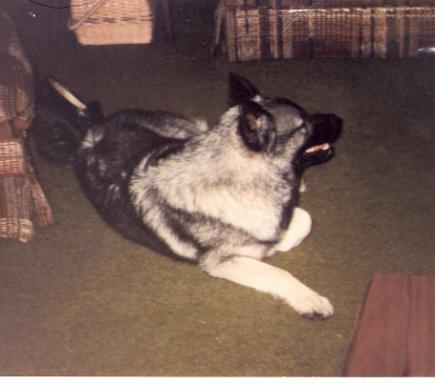
My newest Elkhound also came to me at 6 months old in September of 2011, but he was not shy at all. His main problem was he did not like the rubber mats put down inside the show rings. With some work there as well, he managed to get over it and Jet also has obtained his Canadian Championship. CH QUIQUEN AIR PRESSURE a.k.a. JET is a fun loving kinda guy. He loves kids, cats and my Min Pins. He obtained his Can Ch in 2012 and now we are going to proceed with an Obedience title.
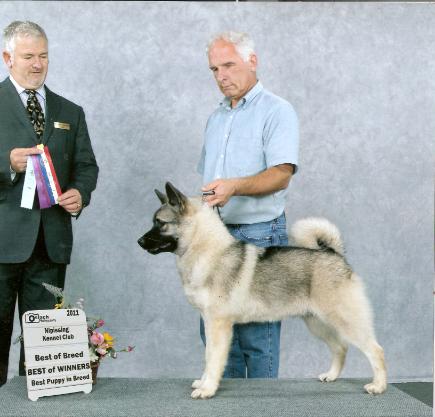
Jet's second w/e out (above) he took a point or two. Breeder/co-owner - Paul Woito - stood in for me in the photo so I could distract the playful puppy.
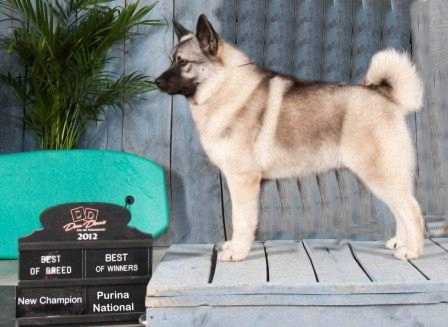
February 2012, Ch Quiquen Air Pressure - (above) took BB over a Specials dog to finish his Canadian Championship.
As of June 2012, Jet is #5 Elkhound in Canada!
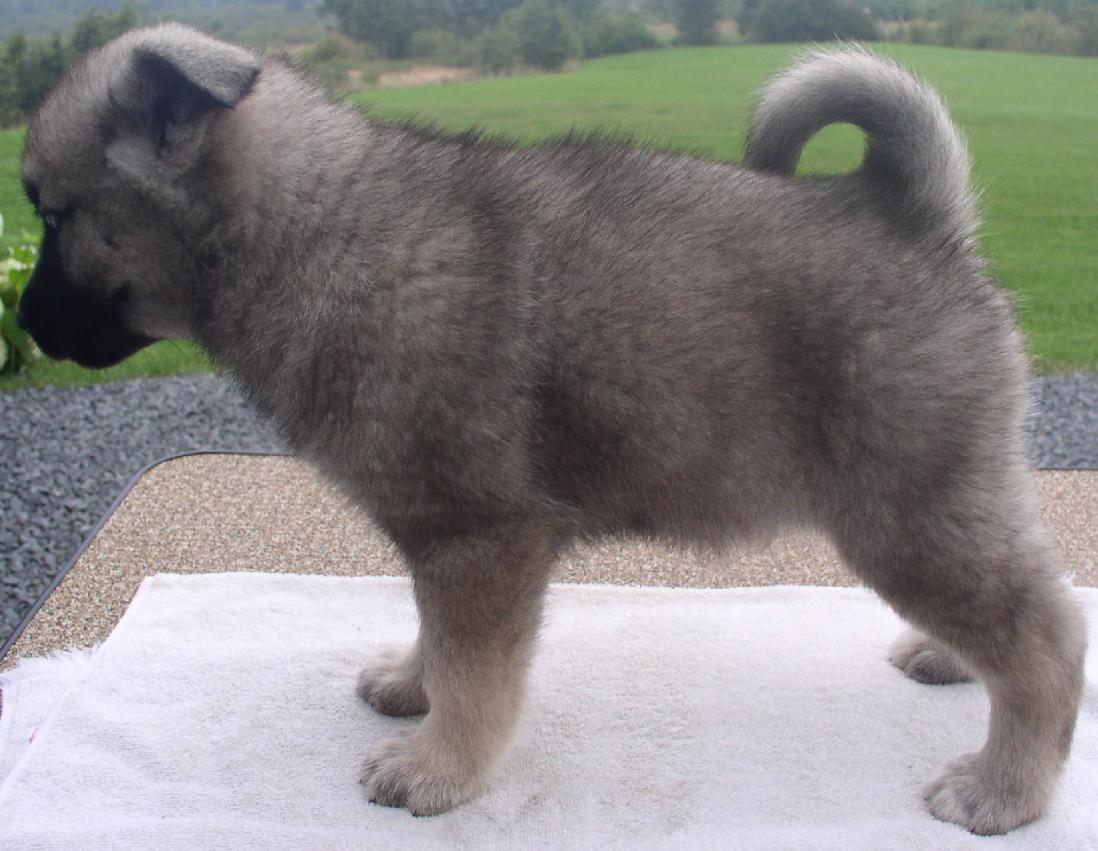
The new addition as of Sept. 2014 - QUIQUEN AIR ALERT - a.k.a. - Rhody! Yes, Jet has a new playmate. Rhody is only 2 months old (above)but he is my next show dog.
Rhody now at 5 months old...
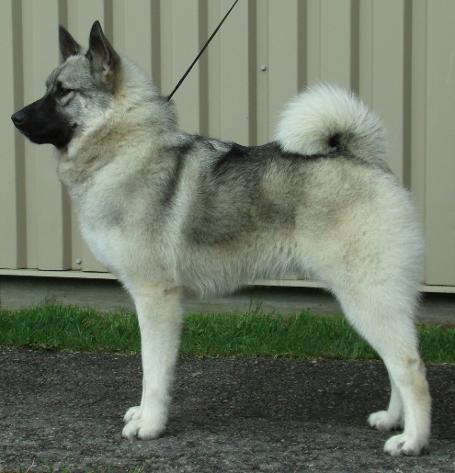
Rhody starting his show career in the Soo...Sr Puppy!
As of 2016, I have been unable to show Rhody due to arthritis but when that lets up a bit, he will return to the ring. He is too good to leave at home.
April 2018 Rhody took his first 2 points toward his Championship !
HISTORY OF THE NORWEGIAN ELKHOUND
The Norwegian Elkhound is a double coated, close coupled, balanced, hardy gray hunting dog of moderate size, whose history goes back over 5000 years to a time when dogs which closely resembled the modern Norwegian Elkhound were canines whose hunting prowess was highly valued. The Norwegian Elkhound evolved over a period of time into a type of dog which, through a combination of physical and mental endowment, was able to perform as an efficient hunter in the rugged environment of the Scandinavian Peninsula. The progenitors of the Norwegian Elkhound that we know today were spitz type dogs, with prick ears, curled tail, thick double coat, bold disposition, strong agile body and wolf-like independence. It was found by mankind that this type of dog, which it is believed to have originated in the area of Denmark, and was known as the Torvemosehunden or Swamp Dog was the best hunter and they became the forerunners of the Northern breeds, which included the Norwegian Elkhound.
These Swamp Dogs migrated northward into Scandinavia, where they gradually evolved into big-game hunters and came to be known as Dyrehund, or large game dogs. The Dyrehund was capable of hunting moose, bear, elk, wolves, and large game birds. They were also defenders of the homestead against marauders. These dogs were used extensively for breeding, which allowed them to perpetuate their qualities.
In the late seventeenth century, severe famine brought about by early winter, which killed many crops before they could be harvested, forced thousands of Finns to migrate westward into Sweden and Norway. They brought with them a strain of Spitz type dog that was used for hunting large upland game birds. This ability was passed down through the generations and many of today's Elkhounds exhibit an aptitude for hunting large birds.
As time progressed, a number of different, but related Elkhound breeds developed throughout the various regions of Scandinavia. These included the Bjornhund, or "Bear Dog", similar to today's Black Elkhound; the red-coated Finnish Spitz, also called the "Barking Bird Dog", which most likely is a descendant of the bird hunting dogs owned by the Finns; the black and white Karelian Bear Dog, considered to be a true moose hunting dog and the Jamthund, a taller and rangier type of dog which evolved in dense forrests of Sweden. Some of these breeds were originally shown together as one breed when dog shows began. One by one, they became individual breeds. In 1937, the Jamthund (the Swedish version of the Gray Elkhound) was separated from the Norwegian Gray that we know today and that is recognized by the American Kennel Club.
In 1865, a dog was whelped which was to become an outstanding hunter, a prepotent sire, and a model for the modern grey Elkhound. This dog, who went by the name of Gamle Bamse Gram was owned by Consul Jens Gram of Ask, Ringerike. He stamped his type strongly on his progeny and was a well-known winner at the earliest dog shows.
In 1887, a preliminary breed standard was drawn up for Moose and Bear dogs and Gamle Bamse Gram was used as the model for the Gray Elkhound. Formal registration of purebred dogs was begun by the Norwegian Kennel Club in 1895 and in 1899 the Norsk Dyrehund Klub was established. In 1900 the "Klub" held a specialty show in Rena, Osterdalen August 11 and 12 with separate entries for the gray and black elkhounds.
The Norsk Elghund Klubb held their 100 year anniversary celebration in Rena Norway on June 19 and 20 1999. This 100 year anniversary event was well attended with 59 Jamthunds, 16 black Norwegian Elkhounds, 6 white Norwegian Elkhounds, 5 West Siberian Laikas, 4 East Siberian Laikas, 2 Karelian Bear Dogs, and 259 Gray Elkhounds.
In 1949, the name of the Norsk Dyrehund Klub was changed to Norske Elghundklubb. Since that time, specialty shows and moose hunting trials for the different elkhound-type breeds have been held annually, as well as forums for judges and symposiums on elkhound standards.
In 1901 the first separate breed Standard for the gray Norwegian Elkhound was drawn up. It was officially accepted in 1906. Final revision was not made until 1950.
Elkhounds In The United States
It is not known for sure when the first elkhounds arrived in this country. The first elkhounds of record are to be found in the 1913 American Kennel Club Stud Book. These three imports were owned by Gottlieb Lechner of Weiser, Idaho. Offspring of these dogs went to R.D. Williams of Rookwood Kennels in Lexington, Kentucky. During the following decade, only 22 Norwegian Elkhounds were registered by the American Kennel Club. In 1924, several imports arrived. The first import of record from England, Bon Bjerke, arrived in 1928.
Ronnie av Glitre was owned by President Hoover and had been a gift to the President from the people of Norway in appreciation for what he did for his friends in Norway in their hour of need during World War I.
The Norwegian Elkhound Association of America was begun around 1930. In 1935 the Association adopted the British breed Standard for the Norwegian Elkhound, which was superseded later that year by the official Standard of Norway.
The Norwegian Elkhound Association of America (NEAA) currently has 13 member clubs in various parts of the country. The NEAA holds a national specialty dog show for Norwegian Elkhounds every two years in different parts of the country. This year's national specialty will include conformation judging by Norwegian judges as well as obedience and agility competition. The NEAA 2008 Specialty will be held in Rochester, Minnesota, May 26 through 30. For more details, go the the NEAA Website.
Appearance
The dog stands about 45-52 cm (20.5") high and weighs up to 24 kg (52 lbs). Its grey, white, and black coat is made up of two layers: an underlying dense smooth coat ranging from black at the muzzle, ears, and tip of its tail; to silvery grey on its legs, tail, and underbody; and an overlying black-tipped protective guard coat along its back. An ideal Elkhound has a tightly curled tail, as the dog shown in the photograph on this page. The Elkhound is a medium-sized dog and extremely hardy.
Temperament
Norwegian Elkhounds are bred for hunting large game, such as wolf, bear and moose. Although the breed is strong and hardy, the dogs typically have an inseparable bond with their masters and are quite loyal. All Elkhounds have a sharp loud bark which makes them suitable as a watchdog.
Norwegian Elkhounds are loyal to their "pack" and make excellent family dogs if given proper attention. It is bold, playful, independent, alert, extremely intelligent, and, at times, a bit boisterous. They rank 36th in Stanley Coren 's The Intelligence of Dogs, being of above average working/obedience intelligence. This is a dog ready for adventure and is happiest if that adventure takes place outdoors in cold weather. It needs daily exercise, lest it become frustrated or even destructive. It is an exceptionally friendly breed. If untrained, it tends to pull when on leash. This dog needs attention for it to understand its place within the family (or the pack), else it may develop social problems and feel neglected. This is a very proud and noble breed that can easily have its feelings hurt if its owner deserts his or her allegiance or duty. An inevitable bond will develop between the dog's family, master, or pack, and if there is disloyalty, the dog will definitely feel it and be hurt. Although each dog is an individual, they generally are very gentle and get along great with children. They are happiest when they feel that they are part of the family. This, combined with their very loud bark, makes them a good watchdog.
Norwegian Elkhounds can be challenging to train because of their intelligence and deep independent streak, but they are acceptable obedience dogs, good-natured, and very understandable in their learning and training. For example, if they fail to "come" because there is something of greater interest in the other direction, they can be quick to learn the importance of the command if taught correctly but they are a willful breed and may never "come" on command. They can be wonderful in agility and are particularly good tracking dogs.
Grooming
Norwegian Elkhound's thick coats are well suited to Norwegian weather, and provide protection from the elements in two main ways. Their outer coats shed rain, snow, and sleet easily, while their under coats keep them warm in low temperatures. Because their coat is so thick, they moult twice a year, producing copious amounts of fur indoors in some rural regions of Norway, this fur is used to make sweaters.
Elkhounds tend to remain clean because their coat sheds most dirt and because they seem to keep themselves clean instinctively. However, Elkhounds require regular everyday brushing especially when they moult to avoid their oil glands becoming plugged and to help them stay cool in summer. However, this can prove problematic for owners in warmer climates, for Elkhounds shed profusely in the summer, leaving soft white down-like hair everywhere.
Some owners save the hair from brushes and combs, spin the cleaned hair into yarn, and crochet or knit with it. The resulting fabric is soft and warm.
Walking
Elkhounds are very powerful animals, bred to hunt all day in cold climates, so they require plenty of exercise to feel satisfied and stay healthy. A minimum of 20 to 30 minute walk twice a day is absolutely necessary and recommended by many breeders. But for an Elkhound in order to feel really satisfied and healthy, daily walks up to two three hours would be the ideal solution. Elkhounds are truly an outside dog at heart and need to have an owner with confidence who has the ability to establish clear dominance in the owner pet relationship. An owner who does not have the ability to establish this dominance will find that an Elkhound may be prone to running off when walking or when the door is open and ignoring any calls or commands by its owner.
Health
Norwegian Elkhounds sometimes carry a genetic predisposition to suffer from progressive retinal atrophy, or, like many medium and large breeds, hip dysplasia, renal problems and cysts, particularly in later life; they are also prone to thyroid problems. Overall, however, they are a hardy breed with few health problems.
Elkhounds are prone to rapid weight gain and must not be overfed.
They have a lifespan of 12-16 years.
More History and Evolution
The Norwegian Elkhound is an ancient breed, having been developed over 6,000 years ago to help early Scandinavians hunt big game such as moose and bear. Remains of dogs remarkably similar to the modern Elkhound have been found in grave sites such as the Viste Cave in Jæren, Norway, where they were dated as far back as 4000-5000 BC [ citation needed ]. Archaeological excavations in Scandinavia suggest this breed existed and was domesticated in the Stone age [ citation needed ]. At the end of the 19th century the breed came to England, and in 1901 the The Kennel Club officially recognized it.
For many years, the Norwegian Elkhound was considered the oldest of all dog breeds, going back further than 6,000 years. Recent DNA analysis suggests, however, that several "ancient" breeds have been "recreated in more recent times from combinations of other breeds" (Ostrander et al., 2004). The researchers found "genetic evidence for a recent origin of the Norwegian Elkhound, believed to be of ancient Scandinavian origin" ( [1] ). But this study only includes 85 of the world's more than 400 dog breeds, omits many primitive lineages, and clusters the breeds together into just four major groups called clades. Nevertheless, some researchers say that the Norwegian Elkhound is a descendant of the ancient "primitive" Pariah Dog that existed 4,000-7,000 years ago. [ who? ]
Of the four major clades that Ostrander et al. clusters together, Clade II includes dogs with the genetic haplotype D8 from two Scandinavian dog breeds: the Norwegian Elkhound and the Jämthund. This genetic sequence haplotype is closely related to two wolf haplotypes found in Italy, France, Romania, and Greece, and is also related to a wolf haplotype found in western Russia (Vila et al., 1997). Clade II appears to be only seen in Norwegian breeds and exhibits a vast amount of divergences. It is suggested that this clade illustrates an ancient and independent origin from wolves that are now extinct (Raisor, 2004). The Norwegian Elkhound evolved, at least partially, from ancestral grey wolf subspecies now found in south central Europe and western Russia and may very well be one of the most ancient of all dog breeds.
In Medieval times it was known as a dyrehound or dyrehund and was highly prized as a hunting dog but rarely seen or bred outside of Norway.
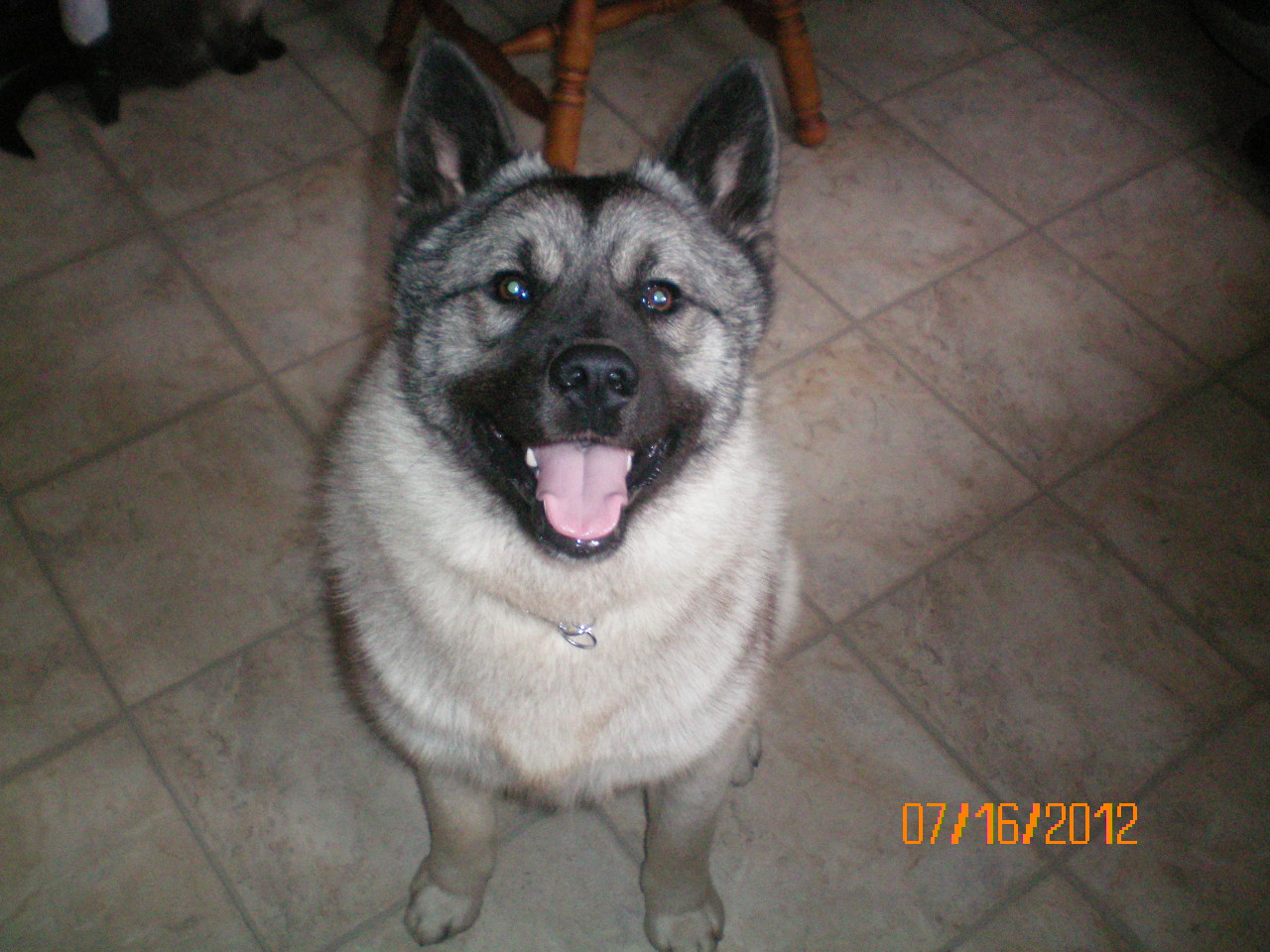
CH QUIQUEN AIR PRESSURE